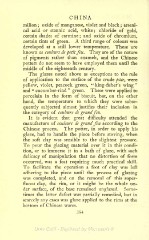Page 480 - Oriental Series Japan and China, Brinkly
P. 480
CHINA
milion oxide of manganese, violet and black arseni-
; ;
cal acid or stannic acid, white chloride of gold,
;
certain shades of carmine and oxide of chromium,
;
Acertain tints of green. third range of colours was
developed at a still lower temperature. These are
known as couleurs de petit feu. They are of the nature
of pigments rather than enamels, and the Chinese
potters do not seem to have employed them until the
middle of the eighteenth century.
The glazes noted above as exceptions to the rule
of application to the surface of the crude pate, were
"
"
yaenldlo"wc,ucviuomlbete,r-preiancdoc"kgrgereene.n, king-fisher's wing
These were applied to
porcelain in the form of biscuit, but, on the other
hand, the temperature to which they were subse-
quently subjected almost justifies their inclusion in
the category of couleurs de grandfeu.
It is evident that great difficulty attended the
manufacture of couleurs de grand feu according to the
Chinese process. The potter, in order to apply his
glaze, had to handle the piece before stoving, when
the soft clay was sensible to the slightest pressure.
To pour the glazing material over it in this condi-
tion, or to immerse it in a bath of glaze, with such
delicacy of manipulation that no distortion of form
occurred, was a feat requiring much practical skill.
To facilitate the operation a foot of clay was left
adhering to the piece until the process of glazing
was completed, and on the removal of this super-
fluous clay, the rim, or it might be the whole un-
der surface, of the base remained unglazed. Some-
times the latter defect was partially remedied, but in
scarcely any cases was glaze applied to the rims at the
bottom of Chinese wares.
394

